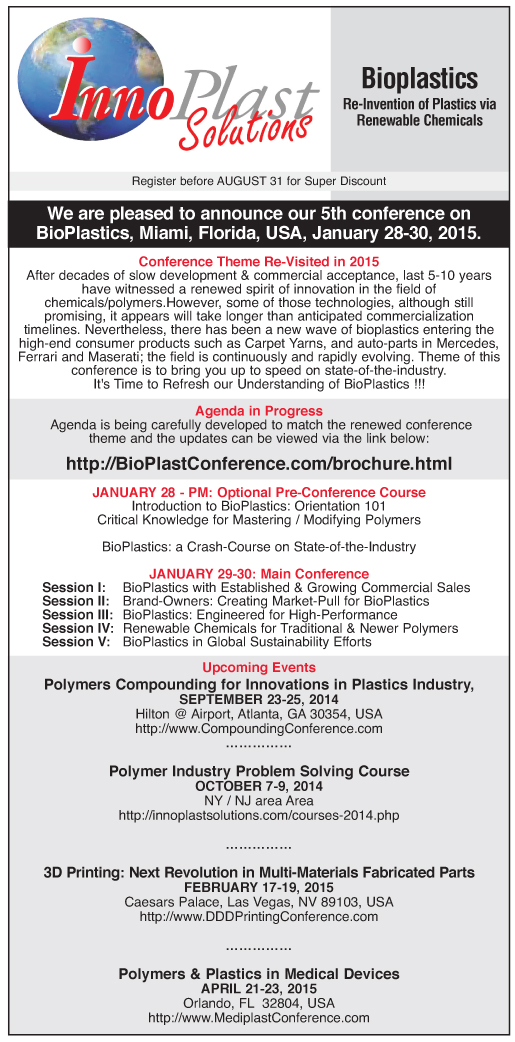Henkel Unveils First Hybrid Structural Instant Adhesive
Henkel Corp. has introduced Loctite® 4090™, a versatile, patented hybrid adhesive that combines the bond strength of a structural epoxy with the speed of an instant adhesive. This powerful combination delivers the first structural cyanoacrylate, an adhesive that offers rapid, high-strength bonding to a range of substrates, along with impact and moisture resistance, and temperature resistance to 300°F (150°C).
Versatile enough to solve both indoor and outdoor design and assembly challenges, the new technology greatly expands the capabilities of cyanoacrylates, especially in applications where traditional instant adhesives offer too little strength or are too brittle.
Loctite 4090 offers high-quality performance in extreme environments and under challenging conditions. The high-viscosity gel adhesive fixtures in 3 to 5 minutes when used to fill gaps up to 0.2 inches (5 mm). The low-blooming product is ideal for appearance-sensitive applications. Because it resists moisture, impact, vibration, and UV light, the adhesive is said to be an excellent choice for outdoor and marine applications. This hybrid material offers high bond strength on a variety of substrates, including metals and most plastics and rubbers, and can be used to bond dissimilar materials.
The adhesive resists chemicals and solvents, especially motor oils, gasoline, ethanol, isopropanol, and water. The product is available as a 50-mL cartridge packaged with five mix nozzles, and should be dispensed with the standard Loctite 50 mL Dual Cartridge Manual Applicator, sold separately.
“The industry is under pressure to be more competitive, to reduce manufacturing costs, and to look for new design and assembly solutions,” says Henkel’s Mike Quail, vice president of Global Marketing, General Manufacturing. “Loctite 4090 has been designed to reach beyond conventional industry approaches. It is the first adhesive of its kind. Never before has there been a hybrid adhesive designed to tackle the most challenging situations.”
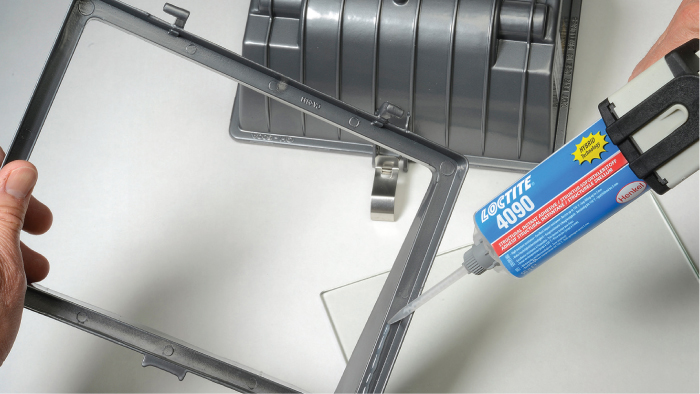
Photo courtesy of Henkel
Henkel Unveils First Hybrid Structural Instant Adhesive
Henkel Corp. has introduced Loctite® 4090™, a versatile, patented hybrid adhesive that combines the bond strength of a structural epoxy with the speed of an instant adhesive. This powerful combination delivers the first structural cyanoacrylate, an adhesive that offers rapid, high-strength bonding to a range of substrates, along with impact and moisture resistance, and temperature resistance to 300°F (150°C).
Versatile enough to solve both indoor and outdoor design and assembly challenges, the new technology greatly expands the capabilities of cyanoacrylates, especially in applications where traditional instant adhesives offer too little strength or are too brittle.
Loctite 4090 offers high-quality performance in extreme environments and under challenging conditions. The high-viscosity gel adhesive fixtures in 3 to 5 minutes when used to fill gaps up to 0.2 inches (5 mm). The low-blooming product is ideal for appearance-sensitive applications. Because it resists moisture, impact, vibration, and UV light, the adhesive is said to be an excellent choice for outdoor and marine applications. This hybrid material offers high bond strength on a variety of substrates, including metals and most plastics and rubbers, and can be used to bond dissimilar materials.
The adhesive resists chemicals and solvents, especially motor oils, gasoline, ethanol, isopropanol, and water. The product is available as a 50-mL cartridge packaged with five mix nozzles, and should be dispensed with the standard Loctite 50 mL Dual Cartridge Manual Applicator, sold separately.
“The industry is under pressure to be more competitive, to reduce manufacturing costs, and to look for new design and assembly solutions,” says Henkel’s Mike Quail, vice president of Global Marketing, General Manufacturing. “Loctite 4090 has been designed to reach beyond conventional industry approaches. It is the first adhesive of its kind. Never before has there been a hybrid adhesive designed to tackle the most challenging situations.”

Photo courtesy of Henkel
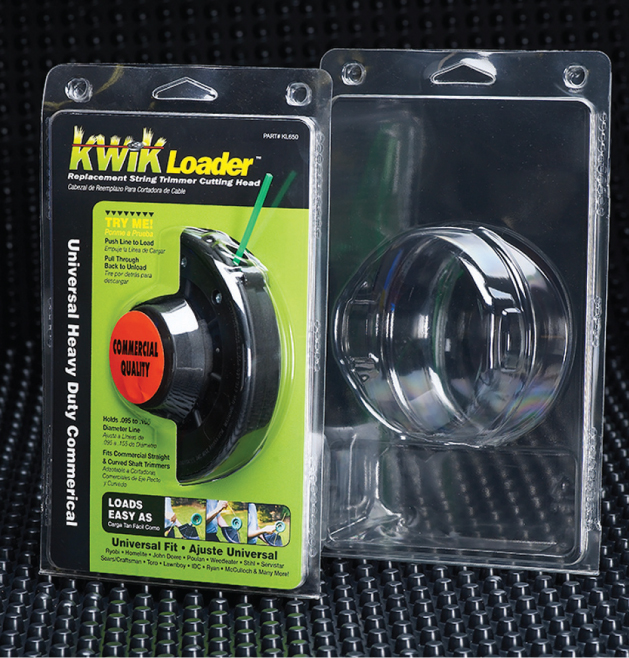
Photo courtesy of Kwik
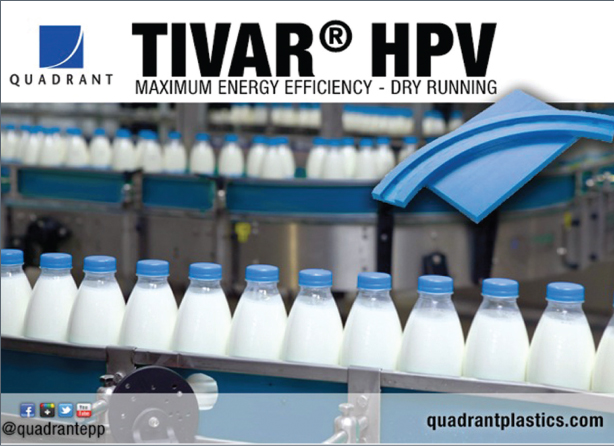
Photo courtesy of Quadrant
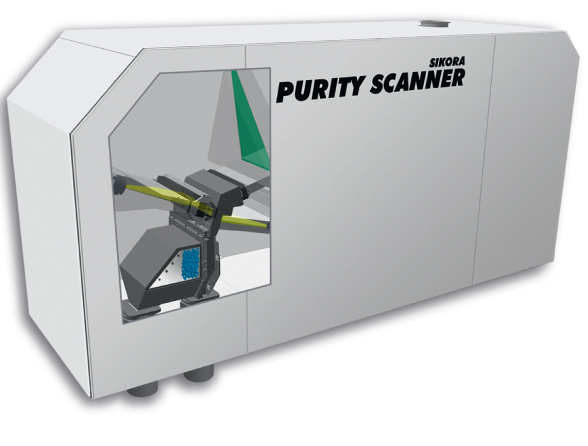
Photo courtesy of Sikora
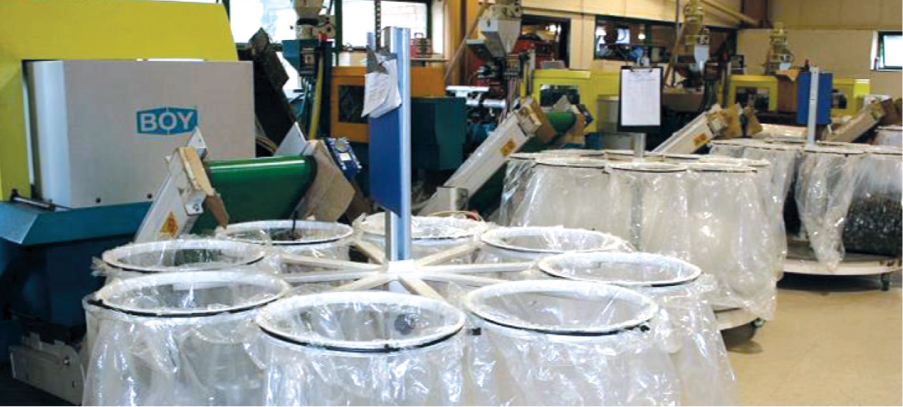
Photo courtesy of ABB
• Kwik Products manufacturers and markets Kwik Loader, “the world’s easiest trimmer head” for string trimmers. Kwik Loader, Line, and Blade products rely on a strong and transparent PVC clamshell package to hang on retailers’ shelves. With increased pressure to limit or eliminate the use of PVC in rigid packaging in California as well as a number of other U.S. states, the manufacturer wanted to change to a more “environmentally friendly” polymer.
Kwik Products uses three Branson 2000 Integrated Welders (IW) from Branson Ultrasonics Corp., two of them since 1999, to ultrasonically weld over two-million PVC clamshell packages annually. To ensure future compliance nationwide, Kwik Products converted from PVC to recycled PET (RPET) for their entire line of products that use the clamshell package. Unfortunately, with this change in material, the company was experiencing a lot of welding issues.
“We had a high rate of poor welds with the RPET, which is far more brittle than the PVC,” says Kwik Products production manager, Ed McConnell. “We tried several setting variations and were not successful.” The solution seemed to require more weld amplitude.
But when Kwik tried increasing amplitude by using a different booster, the increased heat caused the weld to either fully penetrate the RPET or crack the material. The company decided to call in Branson to determine what changes were needed while still maintaining use of their existing Branson 2000 integrated welders.
Working in close collaboration with the manufacturer, Branson tested alternative stitch anvil designs, as well as welder settings and horn designs in its state-of-the-art Application Development Lab in Danbury, Connecticut, USA.
Within just a few weeks, Branson was able to help answer the challenge of the new RPET material and get back into production. Kwik Products reportedly achieved the weld it needed and was able to return to full-scale production with a clamshell package that satisfied the new environmental regulations, shipping millions of clamshells annually.
• RheoSense, Inc. has announced a new addition to its VROC™ family, the e-VROC viscometer. With the same small sample requirements and a wide dynamic range, e-VROC maintains the precision and accuracy of the m-VROC viscometer with one slight twist: the capability of measuring apparent extensional viscosity.
Extensional or elongational viscosity is ideal for studying the complex properties of many fluids used in industrial applications. Monitoring the sample flow through a microfluidic contraction, the system measures the pressure upstream and downstream of a contraction using microelectromechanical systems (MEMS) pressure sensors, and registers changes in the flow. The fluid experiences shear flow in the straight channel, and then an almost constant extension in the contraction zones.
• Quadrant Engineering Plastic Products, global leader of machinable plastics and stock shapes, has introduced TIVAR® HPV, a dry-running UHMW-PE sliding material. It’s uniquely formulated to maximize motion in conveying systems, which delivers greatly reduced energy costs to customers in materials-handling and automation technologies.
With a near-zero level of slip-stick, FDA compliance, and the industry’s lowest available coefficient of friction (COF), TIVAR HPV was specifically developed to virtually eliminate backsliding issues in production environments with high speeds, high temperatures, high loads, and aggressive cleaning agents, filling the performance gap left by other sliding materials.
The superior sliding performance reduces frictional forces, which directly reduces energy consumption, as considerably less drive is required to push the system. The material properties also promote cost savings by protecting parts from wear (specifically expensive sliding partners such as chains and belts).
According to John Fisher, Quadrant PE line manager, Americas, “Components made with TIVAR HPV show improved sliding behavior and high wear and abrasion resistance. This avoids excessive wear and deformation of parts to support the longest possible lifecycle in conveyors, and allow cost, time, and safety benefits. The time required for failure analysis and installation of replacement parts is reduced, therefore the safety and return on your investment improves.”
In developing the material, Quadrant engineers examined the motion and transport segments in the most aggressive and challenging conveying systems to ensure superior performance at all touch points within a conveyor system where friction and wear appear: chain guides, sliding strips and guides, rollers, single and multiple corner wear bends, and straight guides.
“The sliding advantage generates smoother, quieter operation without the need for applied lubricants such as oil and grease, protecting the environment and reducing noise pollution from the equipment,” explains Fisher.
TIVAR HPV virtually eliminates symptoms such as chatter and/or squeaking, providing an extraordinary amount of motion control for high-precision applications. Also, as a fully certified food contact-compliant material, the UHMW-PE also enables system operators the flexibility in production where food regulation requirements are of concern, the company adds.
• The purity of plastic pellets used in the medical, film extrusion, aircraft construction, or automotive industries—or in the production of extra-high-voltage cables—is a decisive characteristic for the quality of the end product. Damage caused by contaminated material can easily run into the millions, and customer claims can cause damage to the image of the company. Therefore, of essential importance is the production of very clean materials, as well as the continuous detection and sorting out of contaminated pellets before they get into the extrusion process.
With its Purity Scanner, Sikora provides a system for a 100% online inspection and automatic sorting of PE pellets. The scanner intelligently combines X-ray technology with an optical system. This allows the detection of metallic and organic impurities of 50 μm in the pellet itself and on its surface to 100%. Contaminated pellets are separated in order to ensure that they do not get into the extrusion process.
The application of both technologies is unique, and is exceeding previous solutions on the market. And due to the specially developed X-ray technology, the Purity Scanner is reportedly the first system that inspects transparent and colored (including black) pellets for impurities and sorts them out automatically.
The scanner not only features a unique measuring technology, but also a novel transport system of the pellets within the device. The feeding of the pellets is carried out via a vibrating ramp. The material does not come into contact with the ambient air, as the transport system is hermetically sealed. Absolute purity is guaranteed, the company adds.
The system is designed for a throughput of 500, 1000, or 2000 kg/hr and can easily be integrated into existing feeding systems. With the new Purity Scanner, the quality and functionality of end products are improved significantly and, thus, the safety and usability for the end-user are increased.
• A plastic components manufacturer is reportedly saving nearly £2,000 a year in energy costs on one of its injection molding machines by retrofitting an ABB variable-speed drive (VSD).
Newtown Plastics fitted the VSD following a joint energy appraisal report by ABB and City Electrical Factors (CEF). As Wayne Trematick, CEF energy consultant, comments, “The energy appraisal showed that the company could save £1,963 on energy costs, with an 18-month payback. This is a very compelling reason for installing drives.”
The company, based in Newtown, Mid Wales, UK, makes a wide variety of molded plastic components, both its own designs and custom designs. These range from display cases to caps and closures, plus a wide variety of components for use in the pharmaceutical, retail, construction, automotive, aerospace, electrical, and other industries.
Following ABB’s energy appraisal, a machine with an 18.5-kW motor was identified as a prime candidate for retrofitting a VSD.
Simon Church, director of Newtown Plastics, explains: “We have 14 machines in total, but this one was identified as suitable because it had such a long cycle time. It operates for 40 weeks a year making a perfume display case, and requires a long cooling time. During this time, the hydraulic motor is not doing any work but is still running at top speed, so this was an obvious choice for an energy-saving project.
“There are several other bigger machines, but these all operate with a faster cycle time, so are not so suitable for VSD control,” he adds.
The process—which has a 50% load and a 50% idle cycle—was logged for seven days to confirm cycle times and on and off load values. Speed control on this application is not controlled via a pressure transducer, but instead relies on the drive’s internal load measurements to decide when the pump is doing useful work or recycling back to the tank.
When the pump is recirculating fluid back to the tank, while the plastic part is being cooled, the speed of the motor is dropped to 50%. Off-load power has been reduced from 7 kW to 3.7 kW, giving the annual savings of £1,963 per year.
“I have been very impressed with the savings from the project,” says Church. “We have a compressor with a VSD, and our new machines come equipped with servo drives, so we know about the technology of VSDs and can’t fault them.”
• Penn Color, Inc., one of the largest color and additive masterbatch producers in the world, announced a major expansion to its existing Research Center located on its 130-acre (0.52 km2) campus in Hatfield, Pennsylvania, USA.
The new expansion—nearly 30,000 square feet (2800 m2)—will be dedicated to the design and development of color and additive masterbatches for the plastics industry. This expansion will enable the company to grow and expand its capabilities for color matching, sample extrusion, accelerated weathering, physical testing, additive development, and new raw material evaluation.
The expansion will also include significant enhancements to its Color Innovation Center, and allow Penn to expand its array of applications equipment, which already includes PET and PP blow molding, film and sheet extrusion, and tube extrusion. Penn Color plans to break ground in the spring of 2015, with completion by the end of the year.
“The additional space and equipment planned for this Research Center will allow Penn Color to do more, faster, to support our growing worldwide customer base,” according to Jim Walsh, technical director of Thermoplastics at Penn Color. “We’re giving our research team the best possible tools to work with, so they can develop new colorants and additives for packaging, industrial films, building and construction, and many other target markets.”
As part of this expansion, the company will also increase the footprint of its analytical laboratory and expand the capabilities. Penn Color currently utilizes instruments for thermal and chemical analysis including MDSC, TGA, dynamic shear rheometry, FTIR, GC/MS, GPC, HPLC, UV/VIS/IR spectrophotometry, and laser-based particle size analysis.
“Penn Color is committed to continue to augment our analytical capabilities for more detailed chemical analysis of plastic compounds, masterbatches, and finished parts, and [to] support our additive and long-term product development groups,” adds Walsh. “Our 24-hour color matching service and sample extrusion will be expanded to support our customers in the plastics markets that demand quick turnaround, including consumer and industrial packaging, single- and multi-layer sheet, and thermoforming, toys, outdoor recreational products, housewares, transportation, and more.”
The new laboratory includes several types of advanced computer color-matching systems, including formulation software used for PET, polyolefins, styrenics, PVC, PMMA, and others. The extensive color database developed for the new color-matching systems is currently being integrated throughout Penn Color’s R&D and quality control laboratories worldwide.
Another highlight of the new Plastics Design Center will be a Customer Innovation Area. “This will provide exciting new interactive and hands-on service to increase the speed and enhance the experience of new color development,” says Bob Kaminski, director of market development at Penn. “Brand owners and converters will be able to view an extensive library of color concepts [and] collaborate with our research team to create a vision, and our team will convert our customer’s vision into a final part molded on any piece of our applications equipment.”
• Reedy International has hired a new distributor, Cook Chemical. This agreement will better enable Reedy to serve its customers by reducing shipping time and costs. This distributor will also provide technical support to local customers on the U.S. West Coast.
Cook Chemical Co. supplies diversified product lines for manufacturers of asphalt, roofing, sealants and coatings, rubber, plastics, and composites. Established In 1985, Cook Chemical has sustained continuous growth through new partnerships with leading manufacturers of the finest polymers and materials available.
Since 1989, Reedy has provided advanced additive solutions for the plastics industry. A focused approach to the advancement of foam technology has given the company insight into polymer-matching systems, the company adds.
